Kerala Plus Two Macroeconomics Chapter Wise Previous Questions Chapter 2 National Income Accounting
Question 1.
The national product can be measured by using expenditure method, income method and value added method. Prepare the equations to find out GNPMP with these separate methods. (MARCH-2008)
Answer:
National Income is the sum total of the value of goods and services produced in a country during a year. It can be measured using 3 methods namely product method, expenditure method and income method.
Product Method
The process to obtain GNPMP by the product method is: Value added in the primary sector + valued added in the secondary sector + value added in the tertiary sector + Net factor income from abroad.
Income method
The process to obtain GNPMP by the income method is: Compensation of employees + Profit + rent + interest + Mixed Income + Depreciation + Net indirect taxes + Net factor income from abroad
Expenditure method
The process to obtain GNPMP by the expenditure method is: Private consumption expenditure + Investment expenditure + Govt, purchase of goods and services + net exports + Net factor income from abroad.
Question 2.
Prepare self explanatory charts to explain the various concepts related to National Income concepts. (MARCH-2008)
a) GDP
b) PCI
c) NNP
d) PDI
Answer:
a) GDP – > GNP -> Net factor income from abroad
National Income
b) PCI – > \(\frac{\text { National Income }}{\text { Population }}\)
c) NNP – > GNP- depreciation
d) PDI -> Personal Income-direct taxes
Question 3.
Identify the Boxes and flows and complete the following. (MARCH-2009)
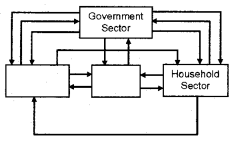
Answer:

Question 4.
The following table shows the different components of domestic factor income for the economy of Malasia. Complete the table by calculating necessary figures. (MARCH-2009)
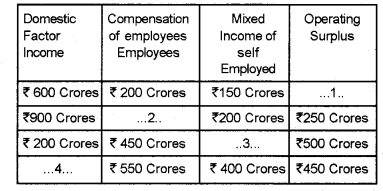
Answer:
Domestic Factor Income = Compensation of employees + Operating surplus + Mixed income of the self employed.
1)250
2)450
3)-750
4) 1400
Question 5.
Give one word for the following statement: (MAY-2009)
a) National income + population
b) A pictural illustration of the interdependence between major sectors and their economic activities.
c) Personal income – direct tax.
d) GNP – Depreciation
Answer:
a) Per capita income
b) Circular flow
c) Disposable income
d) NNP
Question 6.
Suppose that in a two sector economy the value of finished goods is equal to 200 crores and the income generated as factor reward is also equal to 200 crores. The household spend only 160 crores. Then (MAY-2009)
a) What will happen to circular flow?
b) Which system can be introduced to correct circular flow?
c) Name the leakages and injunctions.
d) Draw the flowchart by incorporating new system
Answer:
a) Circular flow of income and expenditure will be disturbed when households spend less than their earnings.
b) Financial system can be introduced to correct the circular flow.
c) Saving is a leakage Borrowing is an injection

Question 7.
between income method and expenditure method of national income measurement. (MARCH-2010)
Hint: The report should have
a) Title
b) Introduction
c) The main points
d) Conclusion win own observation
Answer:
Measurement of National income
Respected teachers and dear friends,
The topic of my seminar paper is ‘measurement of national income or the methods of measuring national income’. The concept of national income occupies an important place in economic theory. National income is the aggregate money value of all goods and services produced in a country during an accounting year. In this seminar paper I would like to present various methods of measuring national income. Introduction
National income can be measured in different ways. Generally there are three methods for measuring national income. They are
- Value added method
- Income method
- Expenditure method Value added method
The term that is used to denote the net contribution made by a firm is called its value added. We have seen that the raw materials that a firm buys from another firm which are completely used up in the process of production are called ‘intermediate goods’. Therefore the value added of a firm is, value of production of the firm – value of intermediate goods used by the firm. The value added of a firm is distributed among its four factors of production, namely, labour, capital, entrepreneurship and land. Therefore wages, interest, profits and rents paid out by the firm must add up to the value added of the firm. Value added is a flow variable.
Expenditure Method
An alternative way to calculate the GDP is by looking at the demand side of the products. This method is referred to as the expenditure method. The aggregate value of the output in the economy by expenditure method will be calculated. In this method we add the final expenditures that each firm makes. Final expenditure is that part of expenditure which is undertaken not for intermediate purposes.
Income Method
As we mentioned in the beginning, the sum of final expenditures in the economy must be equal to the incomes received by all the factors of production taken together (final expenditure is the spending on final goods, it does not include spending on intermediate goods). This follows from the simple idea that the revenues earned by all the firms put together must be distributed among the factors of production as salaries, wages, profits, interest earnings and rents.
That is GDP = W+ P + ln + R
Conclusion:
Thus it can be concluded that there are three methods for measuring national income. These methods are value added method, income method and expenditure method. Usually in estimating national income, different methods are employed for different sectors and sub sectors.
Question 8.
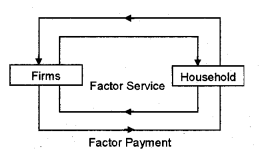
a) Complete the chart showing circular flow of economic activity. (MARCH-2010)
b) Identify money flow and real flow from the figure.
Answer:
a)
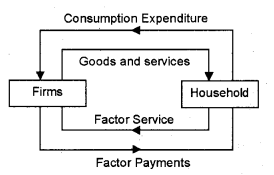
b) Consumption expenditure and factor payments are money flows, flow of goods and services and factor services are real flows.
Question 9.
The GNP is considered as an index of welfare of a country, but there are some limitations of using GNP. Explain the three limitations. (MAY-2010)
Answer:
It is usually argued that GDP is not always a true index of welfare of a country. There are several limitations in using GDP as an index of welfare as discussed below.
1) Distribution of GDP- how uniform is it: If the GDP of the country is rising, the welfare may not rise as a consequence. This is because the rise in GDP maybe concentrated in the hands of very few individuals or firms. For the rest, the income may in fact have fallen. In such a case the welfare of the entire country cannot be said to have increased. If we relate welfare improvement in the country to the percentage of people who are better off, then surely GDP is not a good index.
2) Non-monetary exchanges: Many activities in an economy are not evaluated in monetary terms. For example, the domestic services women perform at home are not paid for. The exchanges which take place in the informal sector without the help of money are called barter exchanges. In barter exchanges goods (or services) are directly exchanged against each other. But since money is not being used here, these exchanges are not registered as part of economic activity. In developing countries, where many remote regions are underdeveloped, these kinds of exchanges do take place, but they are generally not counted in the GDPs of these countries.
This is a case of underestimation of GDP. Hence GDP calculated in the standard manner may not give us a clear indication of the productive activity and well-being of a country.
Externalities: Externalities refer to the benefits or harms a firm or an individual causes to another for which they are not paid or penalized. Externalities do not have any market in which they can be bought and sold. In case of externalities whether positive or negative, it may not reflect the true picture of the economy. That is in the case of externality, GDP will underestimate the actual welfare of the economy.
Question 10.
using three methods: (MAY-2010)
a) Identify the three methods.
b) Prepare the equations to find out GDP with these separate methods.
Answer:
a) Product method, Income method, Expenditure method
b) Product method 
Income method: GDP = C + S + T
Question 11.
Prepare a seminar report on the topic ‘Product Method and Income Method of National Income Measurement’. (MARCH-2011)
The report should contain
a) Title
b) Introduction
c) Main points
d) Conclusion with own observation
e) Order of presentation
Answer:
Measurement of National income Respected teachers and dear friends, The topic of my seminar paper is ‘measurement of national income or the methods of measuring national income’. The concept of national income occupies an important place in economic theory. National income is the aggregate money value of all goods and services produced in a country during an accounting year. In this seminar paper I would like to present various methods of measuring national income.
Introduction
National income can be measured in different ways. Generally there are three methods for measuring national income. They are
- Value added method
- Income method
- Expenditure method Value added method
The term that is used to denote the net contribution made by a firm is called its value added. We have seen that the raw materials that a firm buys from another firm which are completely used up in the process of production are called ‘intermediate goods’. Therefore the value added of a firm is, value of production of the firm – value of intermediate goods used by the fine. The value added of a firm is distributed among its four factors of production, namely, labour, capital, entrepreneurship and land. Therefore wages, interest, profits and rents paid out by the firm must add up to the value added of the firm. Value added is a flow variable.
Expenditure Method
An alternative way to calculate the GDP is by looking at the demand side of the products. This method is referred to as the expenditure method. The aggregate value of the output in the economy by expenditure method will be calculated. In this method we add the final expenditures that each firm makes. Final expenditure is that part of expenditure which is undertaken not for intermediate purposes.
Income Method
As we mentioned in the beginning, the sum of final expenditures in the economy must be equal to the incomes received by all the factors of production taken together (final expenditure is the spending on final goods, it does not include spending on intermediate goods). This follows from the simple idea that the revenues earned by all the firms put together must be distributed among the factors of production as salaries, wages, profits, interest earnings and rents.
That is GDP = W+ P + In + R
Conclusion
Thus it can be concluded that there are three methods for measuring national income. These methods are value added method, income method and expenditure method. Usually in estimating national income, different methods are employed for different sectors and sub sectors.
Question 12,
Pick out the correct equation. (MARCH-2011)
a) GDP = GNP + Net factor income from abroad
b) NNP = GNP – Depreciation
c) NDP = GDP – Net Indirect Tax
d) NNP = GNP-Net Indirect Tax
Answer:
NNP = GNP – Depreciation
Question 13.
The term used to refer the benefits (or harm) a firm or an individual causes to another firm or an individual for which they are not paid is (MARCH-2012)
a) Welfare
b) Externalities
c) Transfer Payments
d) Internal Economies
Answer:
b) Externalities
Question 14.
Identify the real and nominal flows in the circular flow of income. (MARCH-2012)

Answer:
Real flows
Factor services
Final goods and services Nominal flows
Factor incomes
Expenditure on goods and services
Question 15.
GDP Deflator refers to (MARCH-2012)
a) The ratio of real to nominal GDP.
b) The ratio of nominal to real GDP.
c) The ratio of nominal N to real GDP.
d) The ratio of nominal GDP to nominal GNP.
Answer:
b) The ratio of nominal to real GDP.
Question 16.
From the data given below, calculate (MARCH-2012)
a) GDP at market price.
b) Net National Income at Factor Cost.
c) Personal income.
Data :
1) NDP at market price – ₹74,905
2) Net indirect taxes – ₹8,344
3) Income from Domestic product accuring to Govt. – ₹1,972
4) Net factor income from abroad – ₹(-) 232
5) Current transfers to households – ₹2,305
6) Depreciation – ₹4,486
Answer:
a) GDP at market price
GDPMP = NDPMP + Depreciation
= ₹74905 + 4486 = ₹79,391 .
b) Net National Income at factor cost
NNPFC = NDPMP – Net indirect tax + Net factor income from abroad = 74905-8344+ (-) 232 = 7 66,329
c) Personal income
= NNPFC+Current transfers to households = 66329 + 2305= ₹68,634
Question 17.
List of some variables are given below. Classify them in a table into stocks and flows. (MARCH-2013)
i) Wealth
ii) Income
iii) consumption
iv) Investment
v) Expenditure
vi) Capital stock
Answer:
Stock variables
- wealth
- capital stock
flow variables
- income
- consumption
- investment
- expenditure
Question 18.
From the following information, calculate GNP and NDP (₹ in crores) (MARCH-2013)
i) GDPMP 65,665
ii) Consumption of fixed capital 2,250
iii) Net factor income from abroad 750
Answer:
GNP = GDP + Net factor income from abroad GNP =65,665 + 750 = 66415 Crores
NDP = GDP – depreciation (Consumption of fixed capital)
NDP =65665-2250 = 63415 Crores
Question 19.
The value of the nominal GDP of India was ₹ 2,800 crores during the year 2011. The value of GDP of the country during the same year evaluated at the price of some base year was ₹3,200 crores. Find the value of GDP deflator of the year in percentage terms. (MARCH-2013)
Answer:
The ratio of nominal GDP to real GDP is known as GDP deflator
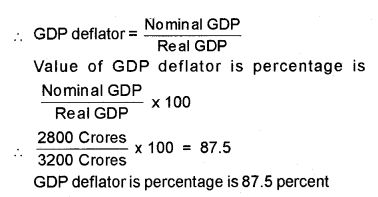
Question 20.
Though Gross Domestic Product (GDP) is often used as an indicator of economic welfare, it is not a comprehensive indicator of welfare. Elaborate. (MAY-2014)
Answer:
GDP deflator = Current year GDP / Base year GDP x 100 = 1800/1200 x 100 = 1.5 x 100
= 1.5 (in percentage terms 150)
Question 21.
Pick the odd one and justify your answer. (MAY-2014)
a) Product method
b) Deductive method
c) Income method
d) Expenditure method
Answer:
deductive method. All others are methods for measuring national income.
Question 22.
Identify the central/basic economic problems. (MAY-2014)
i) What is to be produced?
ii) What is to be regulated?
iii) How goods are to be produced?
iv) How sectors are to be divided?
v) How produced output is to be divided?
vi) How much is to be produced?
Answer:
Basic economic problems are
i) what to produce
iii) how goods are to be produced
vi) how much is to produced
Question 23.
Define value added method. A farmer produces 5 quintals of wheat, out of which he sells 3 quintals to a flour mill and 1.5 quintals to consumers at the rate of ₹1000 per quintal. He retains the balance of 0.5 quintals of self-consumption. For wheat cultivation he spends ? 2000 on account of purchasing seeds and fertilizers. Calculate value added by the farmer (MARCH-2015)
Answer:
The real value added in the production process is called Gross value added.
Gross value added = Value of output – Intermediate consumption
Gross value added = 5000 – 2000 = 3000
Question 24.
Suppose in a two sector economy goods worth ₹150 crores are produced and income generated is also equal to ₹150 crores. Draw circular flow of economic activities in this economy and explain. (MAY-2015)
Answer:
The inter related process of production, income generation and expenditure is called circular flow of income. In the given two sector economy, the flow of economic activities can be in the following way.
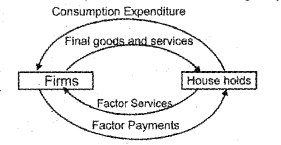
In this sector households receive ₹150 crore for their factor services given to firms. Firms in reply, provides goods and services to household sector to firms as consumption expenditure.
Question 25.
Write down the three identities of calculating the GDP of a country by the three methods. Also explain why each of these should give us the same value of GDP.(MAY-2015)
Answer:
Gross National Product (GNP) equals Gross National Income equals Gross national expenditure i.e.
GNP = GNI = GNE
These are equal because national income is a circular flow of income. Aggregate expenditure is equal to aggregate output which in turn, is equal to aggregate income. However each method has some different items, yet they show exactly identical results. Their identity can be shown in the following manner: Reconciling Three Methods of Measuring Gross
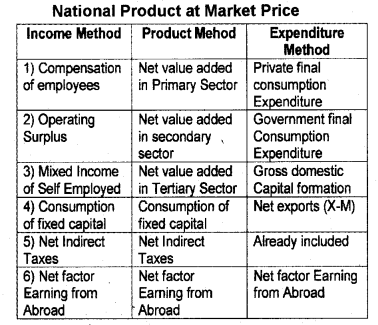
Question 26.
Fill in the blanks :
a) A balanced budget multiplier is unity implies that ₹100 increase in ‘G’ increases National Income by (MAY-2015)
b) Gross primary deficit = ________
Answer:
a) ₹100
b) Gross primary deficit = Gross fiscal deficit – net interest liabilities.
Question 27.
Fill in the blanks : (MARCH-2016)
a) GDP + ______ = GNP
b) GNP – Depreciation = ______
c) ________ – Net Indirect Taxes = NNPFC
(GDP – Gross Domestic Products
GNP – Gross National Products
NNPFC – Net National product at factor cost)
Answer:
a) Net factor income from abroad
b) NNP
c) NNPMP
Question 28.
You are to be cautions while taking only GDP (Gross Domestic Product) as index of welfare. Why so? (MARCH-2016)
Answer:
GDP deflator = Current year GDP / Base year GDP x 100
= 1800/1200 x 100
= 1.5 x 100
= 1.5 (in percentage terms 150)
Question 29.
If the quantity demanded of ‘good’ X’ increases with a rise in the price of ‘good Y’, these goods are ________ (MAY-2016)
a) complementary goods
b) Inferior goods
c) Normal goods
d) Substitute goods
Answer:
d) Substitute goods
Question 30.
Differentiate between the stock variables and flow variables with examples. (MAY-2016)
Answer:
Stocks and flows
There are differences between the concepts of stocks and flows. Stock is a variable measured at appoint of time, whereas, flow is a variable measured over a period of time. Wealth, capital etc are variables which can be measured at a point of time. Therefore, they are stock variables. At the same time, income, output, profits etc are concepts that make sense only when a time period is specified. These are called flows because they occur in a period of time. Therefore we need to delineate a time period to get a quantitative measure of these.
Net Investment -> Flow
Capital -> Stock
Question 31.
Write down the three identities of calculating the GDP of a country by the three methods. Also briefly explain why each of these should give us the same value of GDP. (MAY-2016)
Answer:
Gross National Product (GNP) equals Gross National Income equals Gross National Expenditure,
i.e. GNP = GNI = GNE
These are equal because national income is a circular flow of income. Aggregate expenditure is equal to aggregate output which in turn, is equal to aggregate income. However each method has some different items, yet they show exactly identical results. Their identity can be shown in the following manner: Reconciling Three Methods of Measuring Gross.

